-
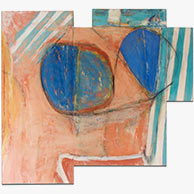 Blue Discs
Blue Discs
2012, 38"x39.5"x3", Casein on wood panel -
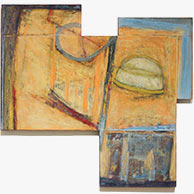 East West
East West
2012, Casein on wood panel -
 Global
Global
2012, 76.5"x40"x3", Casein on wood panel -
 Map
Map
2012, 48.5"x43.5"x3", Casein on wood panel -
 Marble
Marble
2012, 37"x57"x3", Casein on wood panel -
 Mark
Mark
2012, 39.5"x38"x3", Casein on wood panel -
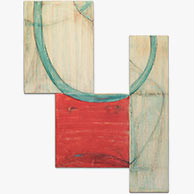 Red Dispatch
Red Dispatch
2012, 41"x31.5"x3", Casein on wood panel -
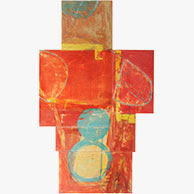 Red Skip
Red Skip
2012, 59"x35"x3", Casein on wood panel -
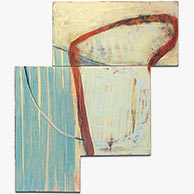 Sliding Arc
Sliding Arc
2012, 40.5"x35"x3", Casein on wood panel -
 Target
Target
2012, 39"x38"x3", Casein on wood panel -
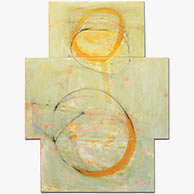 Yellow Drawing
Yellow Drawing
2012, 54.5"x41"x3", Casein on wood panel
Circles and other Projections
2012, Casein on wood panels
 This series brings together research threads and years of making painting and sculpture, with the experience of living and working abroad. Fels began showing color-field paintings and collages in the 1970s, their palette and surface treatment reflecting long periods of time spent in Italy. Living and working in Italy in 1972 and 1978, he looked
This series brings together research threads and years of making painting and sculpture, with the experience of living and working abroad. Fels began showing color-field paintings and collages in the 1970s, their palette and surface treatment reflecting long periods of time spent in Italy. Living and working in Italy in 1972 and 1978, he looked  at many fading and stained walls, which then were painted with tempera-based paints that slowly and beautifully oxidized. He also studied 12th and 13th century altarpieces, wooden constructions with articulated panels, also painted with tempera. Professor Joel Brink, a knowing scholar of 14th century panel-painting, tutored Fels about their history, technique and importance. Together they made frequent trips to Florentine churches and closely examined altar pieces there. He also traveled to Siena to study the sublime work of the same period in the Sienese Pinacoteca.
at many fading and stained walls, which then were painted with tempera-based paints that slowly and beautifully oxidized. He also studied 12th and 13th century altarpieces, wooden constructions with articulated panels, also painted with tempera. Professor Joel Brink, a knowing scholar of 14th century panel-painting, tutored Fels about their history, technique and importance. Together they made frequent trips to Florentine churches and closely examined altar pieces there. He also traveled to Siena to study the sublime work of the same period in the Sienese Pinacoteca.
Returning to Italy in 1985-6, Fels began painting with tempera paint on paper, mounted on wooden supports. Those years also saw the beginning of the public facet of his art practice; Fels completed an intervention  in the streets of Bologna that led to his first museum show, in the city’s contemporary art museum. Back in the NW, he continued making art
in the streets of Bologna that led to his first museum show, in the city’s contemporary art museum. Back in the NW, he continued making art  in public places, which by necessity took on a sculptural dimension. Born with only one fully functional eye and therefore without benefit of full binocular vision, Fels had to train himself as a teenager
in public places, which by necessity took on a sculptural dimension. Born with only one fully functional eye and therefore without benefit of full binocular vision, Fels had to train himself as a teenager  in seeing three-dimensionally, something which comes completely automatically to most everyone. This physical handicap turned into a philosophical fascination, as he found himself more and more intrigued by the overlap between two and three-dimensions. As artist in residence for the first year of the new Bellevue Art Museum, he explored the act of looking with devices made in collaboration with lens designer Ed Mannery and the celebration of ambient sound constructed with the Climax Golden Twins. The team, Voluntary Observers, set out to examine the intriguing sense of space in the new Steven Holl designed building.
in seeing three-dimensionally, something which comes completely automatically to most everyone. This physical handicap turned into a philosophical fascination, as he found himself more and more intrigued by the overlap between two and three-dimensions. As artist in residence for the first year of the new Bellevue Art Museum, he explored the act of looking with devices made in collaboration with lens designer Ed Mannery and the celebration of ambient sound constructed with the Climax Golden Twins. The team, Voluntary Observers, set out to examine the intriguing sense of space in the new Steven Holl designed building.
 Later that year on an artist residency in Trivandrum, India, Fels completed his first collaboration with billboard painters for a series that now hangs in the Honors College of U/W Tacoma. He also rediscovered tempera paints, called distemper there, brought to India by the British. Like the Italians before them, the Indians use the paint to cover exterior as well as interior walls, and once again he found himself mesmerized by the natural life of tempera exposed to the elements. Fels began painting with distemper on discarded cardboard obtained from recyclers. Living and working in India four more times between 2002 and 2008, he continued the large-scale billboard work and on a much more private scale, explorations with distemper.
Later that year on an artist residency in Trivandrum, India, Fels completed his first collaboration with billboard painters for a series that now hangs in the Honors College of U/W Tacoma. He also rediscovered tempera paints, called distemper there, brought to India by the British. Like the Italians before them, the Indians use the paint to cover exterior as well as interior walls, and once again he found himself mesmerized by the natural life of tempera exposed to the elements. Fels began painting with distemper on discarded cardboard obtained from recyclers. Living and working in India four more times between 2002 and 2008, he continued the large-scale billboard work and on a much more private scale, explorations with distemper.
The 2004-5 stay in India was preceded by two years researching the voyages of discovery of the 1500s. Ushering in the age of global trade, Vasco da Gama arrived in South India in 1498. The series of billboards he completed with sign-painters in Cochin examines da Gama’s legacy is still touring nationally. Sixteen of the large paintings make up an exhibition organized by the Tacoma Art Museum in 2007.

 Conceptually, Da Gama’s world-circling voyage was made possible by seminal work on perspective carried out by Italian artist/scientists. Fels immersed himself in study of their treatises and the devices they created and imagined for mimicking perspective. He was fascinated
Conceptually, Da Gama’s world-circling voyage was made possible by seminal work on perspective carried out by Italian artist/scientists. Fels immersed himself in study of their treatises and the devices they created and imagined for mimicking perspective. He was fascinated  again by the confluence of painting and the invocation of space. In India he looked at 17th and 18th century gauche and distemper astronomical studies on paper. This in turn led him to early European geometrical, astronomical and alchemical works.
again by the confluence of painting and the invocation of space. In India he looked at 17th and 18th century gauche and distemper astronomical studies on paper. This in turn led him to early European geometrical, astronomical and alchemical works.  Concerned with heavenly systems, the diagrams and depictions often featured circles or spheres. In 2010, he worked in the medieval city of Girona on a print series sponsored by Davidson Galleries and Michael Dunev Projects in Spain.
Concerned with heavenly systems, the diagrams and depictions often featured circles or spheres. In 2010, he worked in the medieval city of Girona on a print series sponsored by Davidson Galleries and Michael Dunev Projects in Spain.
 Girona was home to the first printed books on the Kabala, another important ancient system dedicated to the heavens and man’s place in it. And once again, circles and spheres played a strong role in cabalistic diagrams.
Girona was home to the first printed books on the Kabala, another important ancient system dedicated to the heavens and man’s place in it. And once again, circles and spheres played a strong role in cabalistic diagrams.
 The paintings in this series are an invocation of these influences, painted in the summer of 2012 in the studio in the bucolic Cascade foothills, but informed by decades of research and wide-spread, mostly intensely urban, cultural absorption. They are of course neither mathematical nor art historical treatises, not religious or magical manifestations.
The paintings in this series are an invocation of these influences, painted in the summer of 2012 in the studio in the bucolic Cascade foothills, but informed by decades of research and wide-spread, mostly intensely urban, cultural absorption. They are of course neither mathematical nor art historical treatises, not religious or magical manifestations.  They are however distemper on flat wood panels exploring the spaces that seem to exist between 2-D and 3-D, between knowledge of the sphere we live on, and our lack of direct experience of it. They also are a personal paean to the circularity of life itself, to the pathways we take seemingly far outside ourselves that somehow knowingly and seamlessly lead us back to our starting places.
They are however distemper on flat wood panels exploring the spaces that seem to exist between 2-D and 3-D, between knowledge of the sphere we live on, and our lack of direct experience of it. They also are a personal paean to the circularity of life itself, to the pathways we take seemingly far outside ourselves that somehow knowingly and seamlessly lead us back to our starting places.